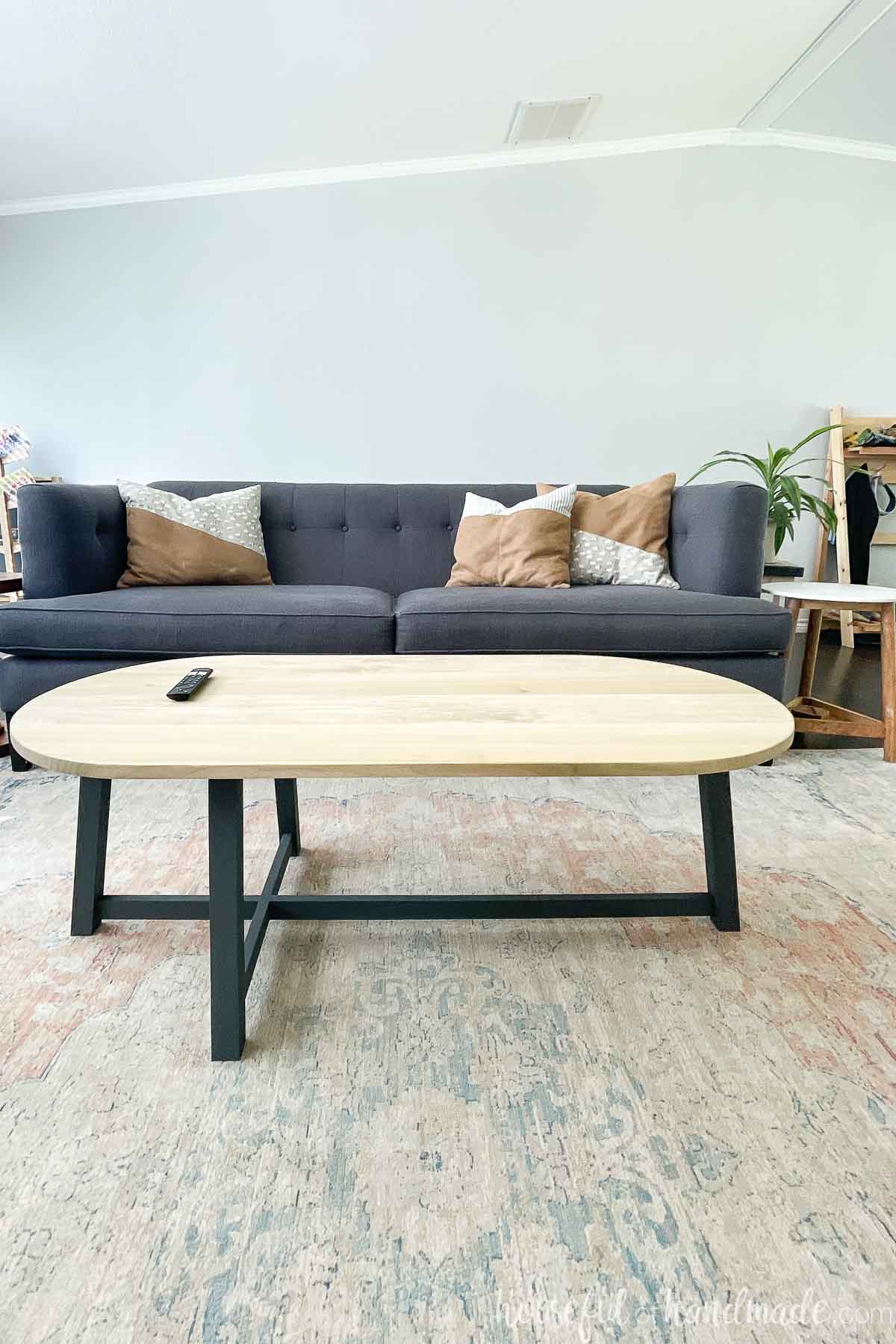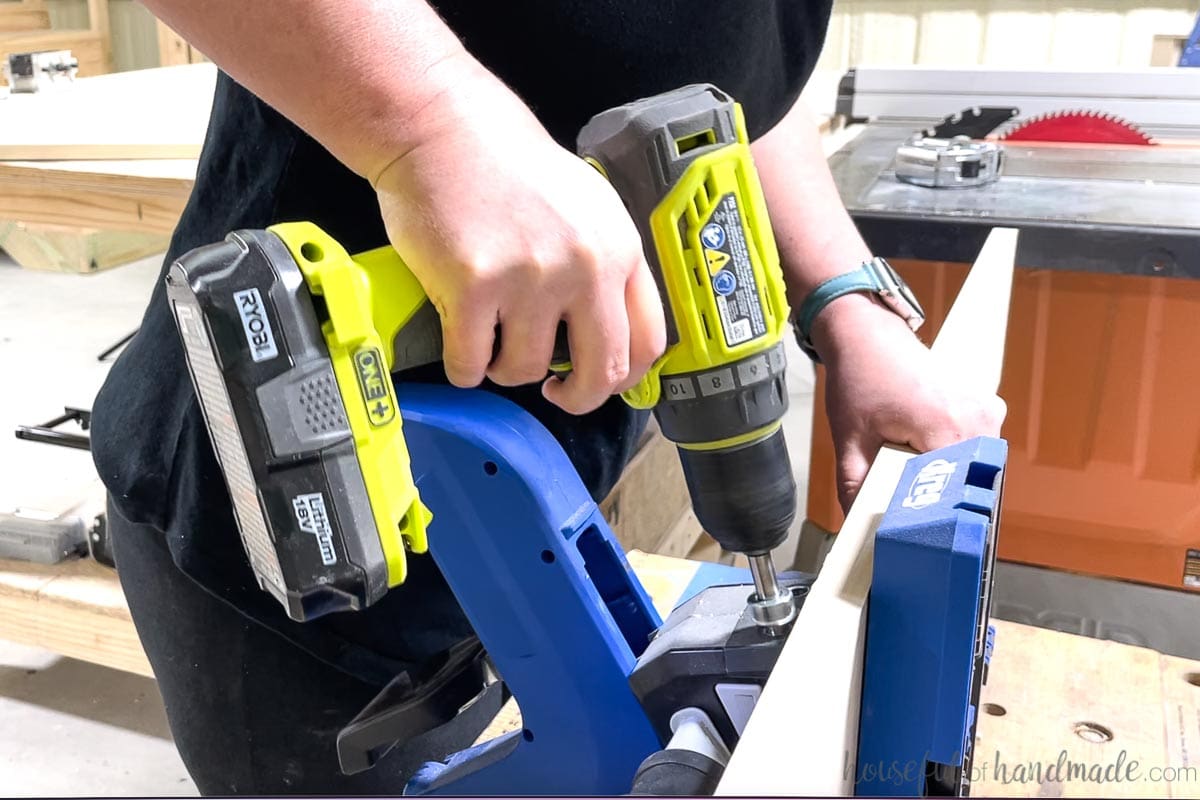I love building coffee tables! They are simple to build, can be made in so many different styles, and are super useful.
Sadly, we didn’t have room to keep the modern coffee table I build last year with us in our move. And we have been living without one for almost a year now. Where is one to set their coffee in the morning???
So this week I remedied the problem with a new asymmetrical coffee table build. I love the unique new design, and this is a simple build consisting of only 2×2 and 1×2 boards for the base and 1×6 boards for the table top.
This post may contain affiliate links. As an Amazon Associate I earn from qualifying purchases. Click here to read my full disclosure policy.

Asymmetrical Table Base
I usually love symmetry, but when designing our new coffee table I was inspired by all the asymmetrical bases. The asymmetry is unique and I feel like it is softer.
Maybe the softness comes from the non-bulky base and rounded top, but either way, I love it!
And I love that this new coffee table has no hard corners. Since I have two kids and a puppy running around the house, less corners is always better.

But one thing to note, this asymmetrical base is not as solid as a standard 4-corner base. The side of the coffee table that is only held up by one leg has a little bit of play to it.
If you have toddlers that climb the furniture, it could tip over. For us, it is plenty solid. My husband even puts his feet up on it (much to my dismay).

So if you have people that might try to get on top of the coffee table, a stronger standard coffee table like this one will hold their weight and not tip over.
But if you need a beautiful coffee table with unique lines that can hold your coffee and remote, this is the coffee table build for you!
Or you could make it more symmetrical with and add strength by adding a second set of side legs on the open side of the table. This would give your table 6 legs total adding additional support to the less solid side of the table.

Coffee Table Finishes
Once the design of the coffee table was done, I had to decide how to finish it!
The base of the table is made out of inexpensive 2x4s that I cut into 2×2 and 1×2 sized boards. You can purchase the correct sized boards if you want, but I was using up scraps and saving $$.
So I knew I wanted to paint the base. To mimic the idea of metal for the asymmetrical base, I painted it a charcoal gray.
I used Rustoleum Chalked paint in Charcoal and it was quick and easy to apply.

The top of the coffee table was built with poplar for a slightly harder table top. I wanted a wood look for the top, but not the slight green hue that can accompany poplar (and was strong in one of my boards).
I grabbed some left over Minwax Weathered Oak stain and tested it on the poplar. It gave the wood a slightly warmer, slightly gray tone and made the grain on the poplar more visible.
On the greener toned board, it did not darken the wood, but it made it blend nicely with the lighter board and I am super happy with how the color turned out.

To finish everything off, I chose to seal the entire table with a furniture wax to give it a light coat of protection without the high gloss or sheen of a poly coating.
I have used waxes on all my coffee table tops and as long as coasters are used for drinks, the tops have held up beautifully to lots of use.
More Simple Weekend Builds
Make something amazing this weekend with these other easy DIY furniture projects.
How to Build a Coffee Table with Asymmetrical Base
Tools & Materials
Recommended Tools:
- Miter saw
- I recently upgraded to this larger sliding miter saw (watch for it to go on sale), but all my projects before were built with this inexpensive miter saw that I loved.
- Doweling jig
- Pocket hole jig
- Drill
- Impact driver (optional, but I love not having to switch bits with the drill)
- Jigsaw
- Clamps
- Sander
Supplies:
- Wood supplies
- (1) 2×2 board, 6’ long
- (1) 1×2 board, 6’ long
- (2) 1×6 boards, 8’ long
- 2″ long 5/16″ doweling pins
- 1 1/4″ pocket hole screws
- Figure 8 fasteners
- 3/4″ wood screws
- Wood glue
- Paint and/or stain
- For the top I used Minwax Weathered Oak stain and for the base I painted it with Rustoleum Chalked paint in Charcoal
Cut List
Cut the pieces according to the details cut list in the premium PDF plans.
Cut 2×2 for the legs with a parallel 10 degree angle on both ends.
Then cut the base support pieces with a 10 degree angle on both ends so they angle towards each other.

STEP 1- Build the Base
The base is assembled with dowels so there is no visible screws.
You could also use pocket holes, but you will want to fill the holes before painting.
Build the Center of the Base
First attach the two smaller support pieces to the large one so they are 12″ from one end. Using the doweling jig, drill 2 5/16″ holes through the 1×2 at the 12″ mark.
With the self-centering doweling jig, I had to get creative to allow me to add 2 holes instead of just one in the center.
I used a scrap of 1×2 and placed it on the top of the 1×2 so the thinner (3/4″ side) was flush with the side I wanted to drill the holes in.
Then I placed the jig over the two pieces and it allowed me to drill 1 dowel hole toward the top of the 1×2.

To drill the other hole, I moved the scrap to the bottom and replaced the doweling jig.
Now I had 2 dowel holes that were drilled completely through the board.

Line the straight side of the shorter base supports up with the dowel holes and mark where you need to drill matching holes on them. Use the jig to drill the holes.
EXPERT TIP:
I use a piece of painters tape to mark the depth I need to drill my holes with the jig. This ensures the holes are deep enough for my dowels to fully seat.
Since I am using 2″ dowel pins through the center of the 1×2, I will split the remaining 1 1/4″ of pin between the two supports.
So the holes were drilled just over 5/8″ deep.

Repeat for the other side support. Dry fit the dowel pins to make sure everything lines up.
Then assemble the base support by adding glue to the dowel holes. Twist the dowel pins through the 1×2 so they stick out evenly on both sides.
Then add glue to the ends of both support pieces and press them onto the dowels. Clamp and allow the glue to dry.

Attach the legs to the Center
The base is attached to the legs so it is 1″ up from the bottom. Mark this line on all the leg pieces.
Then measure and mark where you want to put the dowel pins. Since the 1×2 that is attaching the to legs is 1 1/2″ wide, divide that amount by 3 since you will have 3 sections between the dowels.
So mark the center of each dowel 1/2″ up from the 1″ mark and then 1/2″ up from there.
Line the 1×2 base piece up with the leg and transfer the marks to it. This is where you will be drilling the holes for the pins on the center piece.

Use the doweling jig to drill holes on the legs and base center piece.
I used the same 2″ long dowels but you could use shorter dowels for this connection as well.
The 2″ dowels in the base came close to bottom of the center piece with the angles on the ends.

Dry fit the dowel pins and the connection. Then attach with wood glue and clamp until the glue dries.
Repeat for all the legs.

STEP 2- Build the Top
Cut the 1×6 boards so you have four 48″ long pieces. Lay them out how you want to color and grain to appear on the table top.
Drill pocket holes for 3/4″ thick material in the side of 3 of the boards.
Since the table top will be curved, you will want to sketch out where the curve will be so you do not add pocket holes in this area on the outer boards.

Since the table top is 22″ wide, the curve will be on the outer 11″ of each edge of the table top.
Measure in 11″ on the outside of the outer boards and the inside of the inner boards. Tie a string to a pencil and place it on the mark on the edge of the board. Hold the string on the center mark then draw the curve.
Repeat on the other side.
Attach the top boards together to create a flat table top with wood glue and the 1 1/4″ pocket hole screws. Use face clamps to hold the boards flat as you attach the screws.
Let the glue dry then sand the table top smooth.
Redraw the curve and cut it out with a jigsaw. Then sand the curve to clean it up.

STEP 3- Finish the pieces
Sand all the pieces. I like to start with a 100 or 150 grit sandpaper and then finish with a 220 grit sandpaper.
Paint or stain you pieces however you want. Let them dry fully before final assembly.

STEP 4- Attach the top to the base
Use a forstner drill bit just slightly larger than one side of the figure 8 fastener.
Hold the fastener on the top of the leg so one side it hanging off the inside edge of the leg. Mark the center over the leg.
Place the center of the forstner bit in the center of the mark and drill a hole the same depth as the figure 8 fastener.
If needed, cut away any bits around the center.

Attach the fastener to the top of the leg with a 3/4″ wood screw. Repeat for all legs.
Place the table top upside down on a surface and place the legs on top of it.
The legs will be attached to the table top so the two legs on the curved edges of the table are 3 7/32″ from the edge. And the legs on the sides of the table are set 3 3/32″ from the edge.

When attaching the legs, ensure they are square to the table top.
Secure them to the table top through the figure 8 fastener with 3/4″ wood screws.
And you are done!
Premium plans include:
- Recommended Tools
- Shopping list
- Easy to read cut list table
- Cut diagrams
- Step-by-step instructions with 3D renderings
- Helpful resources
- BONUS: 3D SketchUp file
Now flip your new coffee table over and admire your work.

It's such a fun project that can easily be finished in a weekend.
And you will love the new asymmetrical coffee table. The open bottom adds function without a lot of bulk to your room.
Happy Building!






